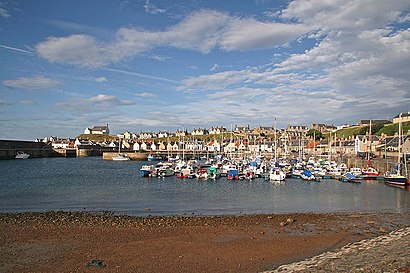See Findochty on the map
Directions to Findochty with public transportation
The following transport lines have routes that pass near Findochty
Bus:
How to get to Findochty by Bus?
Click on the Bus route to see step by step directions with maps, line arrival times and updated time schedules.
Bus stations near Findochty
- Morven Crescent, Findochty,4 min walk,
Bus routes to Findochty
- 35,Macduff,
- 309,Cullen,
- X35,Macduff,
What are the nearest stations to Findochty?
The nearest stations to Findochty are:
- Morven Crescent, Findochty is 253 meters away, 4 min walk.
Which Bus lines stop near Findochty?
These Bus lines stop near Findochty: 35
What’s the nearest bus stop to Findochty?
The nearest bus stop to Findochty is Morven Crescent, Findochty. It’s a 4 min walk away.
What time is the first Bus to Findochty?
The 35 is the first Bus that goes to Findochty. It stops nearby at 08:56.
What time is the last Bus to Findochty?
The 35 is the last Bus that goes to Findochty. It stops nearby at 22:10.
How much is the Bus fare to Findochty?
The Bus fare to Findochty costs about £5.60 - £18.50.
See Findochty on the map

Public Transportation to Findochty
Wondering how to get to Findochty, United Kingdom? Moovit helps you find the best way to get to Findochty with step-by-step directions from the nearest public transit station.
Moovit provides free maps and live directions to help you navigate through your city. View schedules, routes, timetables, and find out how long does it take to get to Findochty in real time.
Looking for the nearest stop or station to Findochty? Check out this list of stops closest to your destination: Morven Crescent.
Bus:
Want to see if there’s another route that gets you there at an earlier time? Moovit helps you find alternative routes or times. Get directions from and directions to Findochty easily from the Moovit App or Website.
We make riding to Findochty easy, which is why over 1.5 million users, including users in Findochty, trust Moovit as the best app for public transit. You don’t need to download an individual bus app or train app, Moovit is your all-in-one transit app that helps you find the best bus time or train time available.
For information on prices of Bus, costs and ride fares to Findochty, please check the Moovit app.
Use the app to navigate to popular places including to the airport, hospital, stadium, grocery store, mall, coffee shop, school, college, and university.
Findochty Address: Main Street street in Findochty

Attractions near Findochty
- Findochty Holiday Cottage
- North East Electrical Systems
- Post Office
- K M Painters & Decorators
- Post Office
- Rosedale
- MacKenzie Multi Construction
- Coastal Pizza
- Russell O'Hanlon
- Victoria's Fake Bake
- Strathlene Beach Car Park
- Strathlene Caravan Site
- Portessie Beach
- W & A Smith
- John Liley Joiner
- Mark Johnston
- Portessie
- Portknockie Chinese Takeaway
- Three Creeks Shore
- Portknockie Cliffs Path
How to get to popular attractions in Findochty with public transportation
- New Gorbals, Glasgow
- Nuffield Health Glasgow Central Fitness & Wellbeing Gym, Glasgow
- Paisley Gilmour Street Railway Station (PYG), Paisley
- IKEA, Loanhead
- Marks & Spencer, Edinburgh
- Asda, Glasgow
- Ocean Terminal, Edinburgh
- Edinburgh Zoo, Edinburgh
- North Berwick, North Berwick
- Asda, Edinburgh
- Cathcart Railway Station (CCT), Glasgow
- Costco Wholesale, Glasgow
- Hard Rock Cafe Edinburgh, Edinburgh
- Edinburgh Christmas Market, Edinburgh
- Dunfermline, Dunfermline
- Edinburgh Castle, Edinburgh
- Queen's Park, Glasgow
- Dundee Railway Station (DEE), Dundee
- Exhibition Centre Railway Station (EXG), Glasgow
- Pleasance Courtyard, Edinburgh